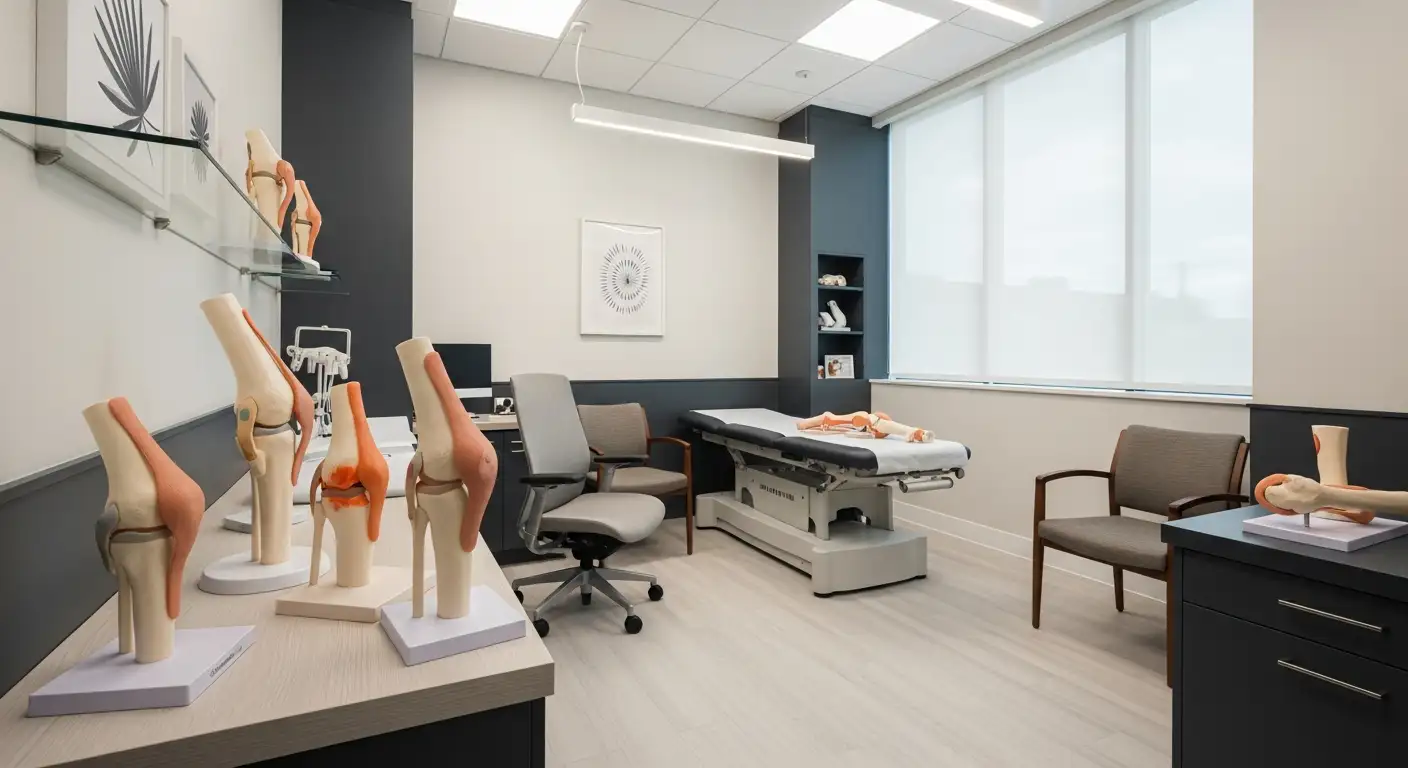Understanding the Critical Role of Ultrasound in Knee Imaging
Ultrasound (US) has emerged as a crucial modality in the assessment of knee disorders, offering a combination of real-time imaging, safety, cost efficiency, and high resolution for superficial structures. Its ability to provide dynamic assessment makes it invaluable not only for diagnosis but also for guiding therapeutic interventions. While MRI remains the gold standard for deep intra-articular structures, ultrasound's unique strengths enable it to complement other imaging techniques, particularly in evaluating soft tissues, detecting effusions, and assessing inflammatory conditions.
Applications of Ultrasound in Knee Pathology
 Ultrasound (US) is increasingly used in the evaluation of various knee conditions due to its high resolution, real-time imaging capabilities, and cost-effectiveness. It is particularly adept at assessing superficial soft tissue structures of the knee, including tendons, ligaments, joint effusions, synovitis, and gout crystals.
Ultrasound (US) is increasingly used in the evaluation of various knee conditions due to its high resolution, real-time imaging capabilities, and cost-effectiveness. It is particularly adept at assessing superficial soft tissue structures of the knee, including tendons, ligaments, joint effusions, synovitis, and gout crystals.
One of ultrasound’s main roles in knee diagnosis is detecting joint effusions and synovitis. It can identify small amounts of fluid and characterize inflammation, which is vital for diagnosing conditions like inflammatory arthritis. For gout, ultrasound can reveal specific signs such as the double contour sign, indicating urate crystal deposition.
Ultrasound excels in assessing ligaments and tendons around the knee. It can detect tears, tendinopathies, and extrusions in the medial and lateral collateral ligaments, as well as patellar tendon injuries. Its dynamic capabilities allow clinicians to observe these structures during movement, providing valuable information about instability or impingement.
While MRI remains the gold standard for evaluating deep intra-articular structures like menisci and complex cartilage lesions, ultrasound provides a rapid assessment for superficial and accessible areas. It is highly sensitive in detecting meniscal tears and cysts such as Baker’s cysts, which appear as anechoic, fluid-filled collections.
In the context of osteoarthritis (OA), ultrasound can evaluate early degenerative changes, such as cartilage echogenicity, cartilage thickness, osteophyte formation, and synovial effusion. Early signs include increased cartilage echogenicity and thickness, whereas advanced OA shows reduced cartilage thickness and osteophytes.
For inflammatory conditions, ultrasound visualizes synovial thickening, hyperemia through Doppler activity, and erosions, making it essential in monitoring disease activity and response to therapy. It can also assist in guiding interventions like joint aspirations and injections, increasing safety and precision.
In code, ultrasound's role encompasses rapid, non-invasive, bedside assessment, capable of identifying soft tissue injuries, joint effusions, and inflammation. Its ability to guide procedures enhances treatment efficacy and minimizes risks.
Though limited in evaluating intra-articular ligaments and deeper structures, ultrasound’s strengths make it a versatile tool in modern knee pathology diagnostics, providing immediate results that facilitate prompt clinical decisions.
What can knee ultrasound show?

Superficial tendons, ligaments, bursae, and menisci
Knee ultrasound excels at visualizing superficial soft tissue structures such as tendons, ligaments, bursae, and portions of the menisci. It provides high-resolution, real-time images that help clinicians identify injuries like tendinopathies, partial tears, and ligament sprains. For example, the patellar tendon and collateral ligaments can be thoroughly examined, revealing thickening, discontinuity, or tears.
However, ultrasound has limitations in assessing deep intra-articular components, such as the posterior horns of menisci and cruciate ligaments, which are better evaluated with MRI.
Joint effusions and synovial thickening
Ultrasound is highly sensitive for detecting joint effusions, even when fluid amounts are minimal—as little as 7 to 10 ml. It appears as anechoic or hypoechoic fluid collections within the joint space, often compressible. Ultrasound also detects synovial hypertrophy and thickening, common in inflammatory conditions like rheumatoid arthritis. Power Doppler enhances this assessment by showing increased vascularity indicative of active inflammation.
Ligament and tendon injuries, tears, and tendinopathy
Ultrasound provides detailed imaging of tendons such as the quadriceps, patellar, and collateral ligaments, aiding in diagnosing tendinopathies, partial tears, or ruptures. It allows dynamic assessment by evaluating tendon movement and elasticity under stress. Vascularity assessed through Doppler signals helps distinguish between normal healing or ongoing inflammation and degenerative changes.
Cystic and soft tissue masses, Baker's cysts
Masses such as Baker’s cysts, which appear as anechoic, compressible fluid-filled structures behind the knee, are easily identified with ultrasound. The characteristic crescent shape and location near the semimembranosus tendon are typical features. Ultrasound can also detect other cystic masses or soft tissue tumors, providing guidance for further management.
Signs of osteoarthritis and degenerative changes
Ultrasound can evaluate signs of osteoarthritis, including cartilage thinning, osteophyte formation, and subchondral bone irregularities. In early osteoarthritis, increased cartilage echogenicity and thickness may be observed, while advanced disease shows reduced cartilage and osteophytes. Detecting intra-articular loose bodies and marginal osteophytes helps assess disease severity.
Detection of cartilage thinning, osteophytes, and intra-articular loose bodies
Particularly useful for osteoarthritis assessment, ultrasound can identify cartilage degradation, including loss of cartilage thickness and surface irregularities. Osteophytes at joint margins and loose intra-articular bodies can be visualized, contributing to the diagnosis and planning of treatment options.
| Structure or Sign | Typical Ultrasound Finding | Additional Notes |
|---|---|---|
| Superficial tendons | Thickening, discontinuity | Tendinopathy or tearing |
| Joint effusions | Anechoic fluid | Detects even small fluid collections |
| Ligament injuries | Hypoechoic disruption | Sprains or tears |
| Baker’s cyst | Crescent-shaped anechoic mass | Common behind the knee |
| Osteophytes | Hyperechoic bony protrusions | Sign of osteoarthritis |
| Cartilage thinning | Reduced thickness, increased echogenicity | Early to advanced osteoarthritis |
| Loose bodies | Hyperechoic intra-articular fragments | Osteochondral loose bodies |
Ultrasound’s portability, immediate results, and ability to guide procedures like joint injections make it a practical choice for initial evaluation and ongoing management of knee pathology. While MRI remains the gold standard for deep and complex intra-articular assessments, ultrasound offers a quick, safe, and cost-effective alternative for many superficial and inflammatory conditions.
Comparing Ultrasound and MRI in Knee Diagnosis
How does ultrasound compare with other imaging modalities like MRI in diagnosing knee problems?
Ultrasound (US) and MRI are both essential in evaluating knee issues, but they offer different benefits and are suited for different situations. MRI is considered the gold standard for examining deep intra-articular structures such as the menisci, articular cartilage, and cruciate ligaments. It provides detailed images with high tissue contrast, making it ideal for complex internal assessments.
In contrast, ultrasound excels at assessing superficial structures like tendons, ligaments, bursae, and detecting joint effusions or cysts. Its ability to perform real-time dynamic imaging helps evaluate mechanical problems such as snapping or clicking and guides interventions like injections.
While ultrasound offers high sensitivity for certain conditions like meniscal and ligament tears, its accuracy can be limited for deep or complex intra-articular lesions. Nevertheless, due to its portability, lower cost, and immediacy, ultrasound often serves as the first screening modality. MRI remains valuable when detailed internal structures need comprehensive visualization, especially if ultrasound results are inconclusive.
Overall, both imaging tools complement each other: ultrasound provides rapid, bedside assessment, and MRI delivers in-depth evaluation. The choice depends on the suspected pathology, clinical context, and resource availability.
| Imaging Modality | Strengths | Limitations | Typical Use Cases |
|---|---|---|---|
| Ultrasound (US) | Portable, real-time, dynamic, cost-effective, no radiation | Limited deep tissue visualization, operator-dependent | Superficial tendon, ligament, effusion detection, guiding procedures |
| MRI | High-resolution, detailed internal joint images, excellent for deep structures | Costly, less accessible, time-consuming | Meniscal tears, articular cartilage, intra-articular ligaments |
This complementary approach ensures comprehensive knee assessment and optimal patient care.
Detection of Specific Knee Injuries and Pathologies

What specific knee injuries and conditions can be detected by ultrasound?
Ultrasound offers a valuable, real-time imaging method for diagnosing various knee problems. It can identify ligament injuries, such as tears or sprains involving the anterior cruciate ligament (ACL), posterior cruciate ligament (PCL), and collateral ligaments. These injuries often appear as hypoechoic, swollen, or disrupted ligaments on ultrasound images.
Meniscal tears are another common pathology detectable with ultrasound. They may show hypoechoic clefts, tears, or degenerative changes within the menisci, aiding in early diagnosis, especially when MRI is unavailable or contraindicated.
Tendinopathies like jumper’s knee (patellar tendinopathy) and Osgood–Schlatter disease can also be visualized. Ultrasound reveals thickening, hypoechogenicity, and sometimes partial tears or fluid around the patellar or quadriceps tendons.
Besides soft tissue injuries, ultrasound can detect joint effusions, synovitis, and bursitis, which are signs of inflammation. Cystic lesions, including Baker’s cysts, appear as anechoic, well-defined fluid collections in the popliteal fossa.
It is particularly effective in identifying osteochondral defects, loose bodies, and soft tissue masses such as cysts or tumors. In traumatic cases, the technique can reveal fractures of the patella, especially cortical disruptions, and assess the integrity of the extensor mechanism.
Overall, ultrasound’s ability to provide dynamic and high-resolution images makes it a practical choice for detecting a broad range of knee injuries and guiding initial management or further evaluation.
Ultrasound Findings in Osteoarthritis and Degenerative Conditions
Ultrasound imaging plays a vital role in detecting and monitoring degenerative changes and osteoarthritis (OA) in the knee. In osteoarthritic or degenerative conditions, typical ultrasonographic signs include joint effusion and synovitis, reflecting inflammation and joint irritation. High-resolution ultrasound can also reveal structural alterations such as cartilage loss, osteophyte formation, and joint surface irregularities, which are hallmarks of degenerative processes.
One specific feature often observed is meniscal protrusions, particularly medial meniscal protrusion (MMP). These protrusions can be accompanied by displacement of the medial collateral ligament (MCLD), indicating joint surface degeneration and meniscal degeneration. The presence of cortical irregularities, calcium deposits within the joint, and subchondral cysts further support the diagnosis of joint degeneration.
Additional signs include Baker's cysts or pes anserinus bursitis, which are common with intra-articular inflammation. Tendinopathies, such as quadriceps or patellar tendinitis, and iliotibial band issues can also be visualized as part of the degenerative spectrum.
Ultrasound helps in assessing the severity of OA by measuring cartilage thickness, detecting osteophytes, and evaluating soft tissue changes over time. These measurements can aid in tracking disease progression or responses to therapy.
Effective evaluation depends on precise technique and standardized protocols. Proper training ensures reliable identification of signs such as cartilage thinning, joint surface irregularities, and soft tissue protrusions. Ultrasound's capacity for dynamic assessment also allows clinicians to observe movement-related symptoms like snapping or clicking linked to degenerative structures.
In summary, ultrasound provides a comprehensive, real-time window into degenerative knee changes, facilitating early diagnosis, ongoing monitoring, and guiding interventions. Its ability to visualize superficial joint structures makes it an invaluable tool in managing osteoarthritis and other degenerative knee conditions.
Search terms: ultrasound signs of osteoarthritis, degenerative knee changes on ultrasound, cartilage and osteophyte detection.
Ultrasound in Evaluating Anterior Knee Pain
 Ultrasound (US) plays an invaluable role in the assessment of anterior knee pain, offering rapid, detailed insights into soft tissue abnormalities around the kneecap. Its ability to visualize superficial structures with high resolution makes it ideal for detecting issues like quadriceps tendinopathy, bursitis, and joint effusions.
Ultrasound (US) plays an invaluable role in the assessment of anterior knee pain, offering rapid, detailed insights into soft tissue abnormalities around the kneecap. Its ability to visualize superficial structures with high resolution makes it ideal for detecting issues like quadriceps tendinopathy, bursitis, and joint effusions.
US can identify quadriceps tendinopathy, typically showing thickening and hypoechoic areas within the tendon, indicating degeneration or partial tears. Bursitis, especially prepatellar and infrapatellar bursitis, appears as anechoic, compressible fluid collections over the bursae. Effusions within the joint are easily seen, even in small volumes, as anechoic or hypoechoic fluid in the suprapatellar recess.
In addition, ultrasound provides assessment of intra-articular structures, including osteophyte formation and cartilage thickness. While limitations exist in evaluating deep cartilage lesions, US can detect superficial osteophytes and signs of cartilage degeneration, such as decreased thickness and altered echogenicity, correlating with pain severity.
Correlating tissue abnormalities with the patient’s pain helps refine diagnosis and guide treatment. For example, the presence of synovial hypertrophy and increased Doppler activity may suggest inflammatory processes like bursitis or synovitis.
US is especially helpful in early detection and management of conditions leading to anterior knee pain. It can identify bipartite patella—an anatomical variant that sometimes causes pain—along with other anomalies, with very high sensitivity.
In clinical decision-making, ultrasound serves as a valuable initial screening tool, particularly when MRI is contraindicated or unavailable. It allows quick differentiation between soft tissue injuries, fluid collections, and bony changes.
While MRI remains the gold standard for detailed cartilage and deeper intra-articular pathology, ultrasound’s speed, safety, and accessibility make it an efficient first step in evaluating patients with anterior knee pain.
Overall, ultrasound-guided diagnosis enhances early intervention, improves treatment accuracy, and can monitor responses to therapy effectively.
Advantages of Ultrasound in Knee Evaluation

What are the advantages of using ultrasound in knee assessment?
Ultrasound provides numerous benefits for evaluating knee conditions. It offers real-time, dynamic imaging, allowing clinicians to see tendons, ligaments, muscles, and surrounding soft tissues in motion. This dynamic capability is crucial for assessing functional impairments, snapping, clicking, and other mechanical symptoms.
Safety is a major advantage; ultrasound uses sound waves, which are non-ionizing, making it a safe method suitable for repeated examinations. Since it is non-invasive, patients experience no discomfort or radiation exposure, broadening its applicability across different age groups and clinical scenarios.
Cost-effectiveness and portability make ultrasound accessible in diverse clinical settings. It is generally less expensive than MRI and can be performed bedside, especially useful in urgent or outpatient evaluations. Its portability allows for quick assessments and comparisons with the unaffected side to improve diagnostic accuracy.
Moreover, ultrasound can guide therapeutic procedures such as joint injections and aspirations, improving precision and safety. High-resolution imaging enables detailed visualization of superficial structures like tendons, ligaments, cysts, and early cartilage changes.
It detects a wide variety of pathologies, including joint effusions, synovial hypertrophy, ligament tears, tendinopathies, cysts, and inflammatory changes. Techniques like Power Doppler help assess blood flow, assisting in diagnosing active inflammation or neovascularization.
Overall, ultrasound's combination of safety, speed, cost-effectiveness, and detailed imaging makes it an invaluable tool in comprehensive knee assessment and management.
Ultrasound's Integral Role in Knee Disease Management
Ultrasound has proven to be an invaluable diagnostic tool in the evaluation of knee conditions due to its high resolution, real-time imaging capabilities, safety, and cost-effectiveness. It provides clinicians with rapid insights into soft tissue injuries, inflammatory changes, and effusions, thereby facilitating early diagnosis and targeted treatment strategies. While MRI remains essential for detailed intra-articular and cartilage assessment, ultrasound's dynamic assessment and accessibility make it an ideal first-line modality and an important adjunct in comprehensive knee evaluation. Continued advancements in ultrasound technology and operator expertise will undoubtedly expand its role, ultimately improving patient outcomes and optimizing knee disorder management.
References
- Evaluation of the knee joint with ultrasound and magnetic resonance ...
- Knee Pain Examined under Musculoskeletal Ultrasonography ...
- An Essential Tool in Diagnosing Patellar Tendon Injuries
- Diagnostic Knee Ultrasound Services in OR, WA, and AZ
- Musculoskeletal ultrasound of the knee - UpToDate
- Diagnostic accuracy of ultrasonography in the assessment of ...
- Comparing Point-of-care-ultrasound (POCUS) to MRI for the ...
- Using ultrasound to diagnose sports injuries and joint pain is faster ...
- Role of Ultrasound in the Evaluation of Painful Knee. A Comparative ...
- Knee pain - Diagnosis and treatment - Mayo Clinic





